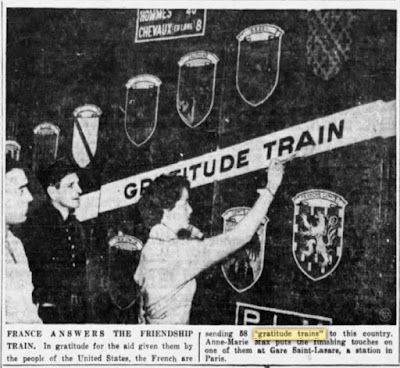FRENCH GRATITUDE CAR TO VISIT DELMAR THIS SUNDAY
TO BE ON DISPLAY FROM 4:45 UNTIL 6
"Commander Ralph Good, of Glen Rayne Post No. 15, The American Legion, announces that plans have been completed for the reception of the Delaware car of the French Gratitude Train, which is to be in Delmar, Sunday February 13. The car which is being taken on a tour of Delaware cities and towns during the week of February 13, by the 40 and 8, the American Legion organization, will arrive in Delmar at approximately 4:45 p.m. and will be on display in front of the Avenue Theatre until 6:00 p.m.
All residents of Delmar and vicinity are urged to view this expression of the gratitude of the French people for the Friendship Train that was sent to France by the by the United States.
Welcoming ceremonies by the Mayor and Town officials of Delmar and Glen Rayne Post have been arranged by past commander, Francis E. Nunvar.
The hundreds of gifts which the car contains are to be distributed to the State of Delaware, the archives, commission of the state, schools, hospitals, orphanages, Veterans administration hospital, catholic Diocese of Delaware, Wilmington Lodge, BPOE, Veterans of Foreign Wars, American Legion, and libraries. There will be no general display of gifts at one place, but each institution which receives a gift will be asked to display them. The gifts will be distributed during the tour.
The State Highway Department will provide the trailer-tractor to be used in transporting the Delaware car on its tour of the state."
As the article stated the French Gratitude railcar came to Delmar. In November 1947, citizens of the United States embarked on a private relief effort to provide aid to war torn France and Italy. This aid was $40 million dollars in supplies filling 700 cars was sent to Europe and was called the "American Friendship Train". There was also a short film documentary called The Friendship Train.

The Freedom Train, painted red, white and blue in Salisbury Maryland in 1947.
A French rail worker and World War II veteran, Andre Picard was so touched by this gesture he suggested France reciprocate. A French veteran’s organization quickly embraced his idea and developed a committee to collect the gifts. A search was conducted to commandeer boxcars from rail yards and depots throughout France to restore them in preparation for their journey. The Railcars themselves were built between 1872 to 1885. Over 52,000 gifts totaling 250 tons were collected to fill 49 boxcars bound for all the states in the U.S. including one car to be shared by the District of Columbia and the territory of Hawaii. Because the French Railcars were too narrow of a gauge to fit our railroad tracks they were carried around to the States on flatbed trucks.
The care of the boxcar was later placed with an independent veteran’s organization, La Societe des Quarante Hommes at Huit Chevaux, referred to as, “The Forty and Eight” society, which was organized in the 1920s by World War I veterans that rode aboard the cars throughout Europe.
The "Forty and Eight" draws its origin from World War I, when the United States had Americans in France to fight "The War To End All Wars." The first thing they ran into was a Voiture boxcar. The narrow gauge railroads of France had box cars that carried little more than half the capacity of American boxcars and these were used to transport the soldiers to and from the fighting fronts. Each boxcar carried carried 40 men or 8 horses (40 hommes et 8 chevaux). The cars were stubby, only 20.5 feet long and 8.5 feet wide. The cars gave their name to a fraternity formed within the American Legion — La Société des Quarante Hommes et Huit Chevaux.

The Delaware Gratitude railcar resides in Seaford at the American Legion there. I measured the car and it is about 8 ft by 20 ft which would give a square footage of 160 ft. If they packed 40 soldiers, with rifles and field packs into each one that would give each person 4 sq ft, or a space 2 by 2 feet. I don’t see how you can even stand in that space.
The Coats of arms on the boxcar represents the provinces of France.
The State of Delaware has a historical sign by the car.
A good website on the cars is at
Merci train

The Delmar American Legion Building has in it this Napoleon bust

The Napoleon bust was donated from France and arrived on the Gratitude Train in 1949. This thank you to America was donated by Madam A. Goujean, 23 Rue Massena, Lyon, France.
so what happened to the other gifts?


No comments:
Post a Comment